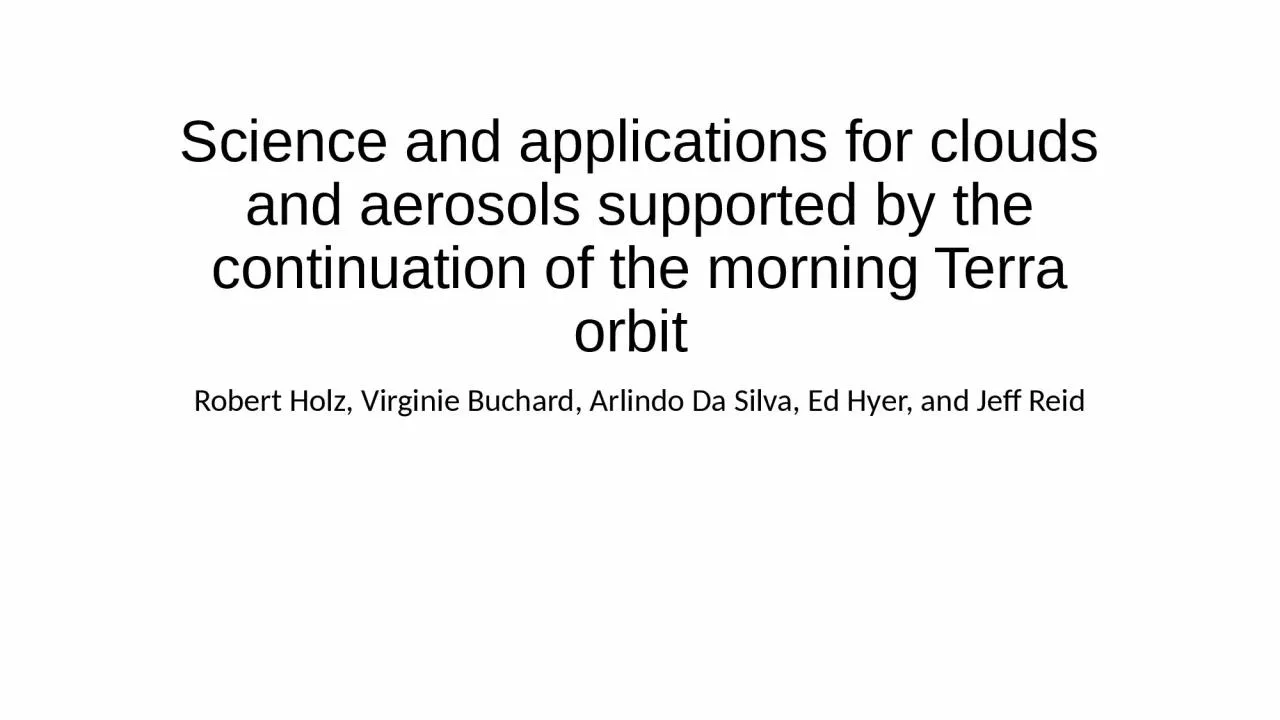

Robert Holz Virginie Buchard Arlindo Da Silva Ed Hyer and Jeff Reid Summary Terra provides the only morning orbit with a modern imager with no current replacement until METOPSG in 2025 ID: 1001633
Download Presentation The PPT/PDF document "Science and applications for clouds and ..." is the property of its rightful owner. Permission is granted to download and print the materials on this web site for personal, non-commercial use only, and to display it on your personal computer provided you do not modify the materials and that you retain all copyright notices contained in the materials. By downloading content from our website, you accept the terms of this agreement.
1. Science and applications for clouds and aerosols supported by the continuation of the morning Terra orbit Robert Holz, Virginie Buchard, Arlindo Da Silva, Ed Hyer, and Jeff Reid
2. SummaryTerra provides the only morning orbit with a modern imager with no current replacement until METOP-SG in 2025If retired next year, HVHRR/3 on METOP B/C will be the morning imager with daily coverage unit METOP-SGHVHRR-3 is a 6-channel imager lacking on orbit calibration, with MODIS Terra being the first imager with on orbit calibration when launched in 1999Well calibrated observations are needed for aerosol and cloud climate records K. Meyer et al.: Derivation of Shortwave Radiometric Adjustments for SNPP and NOAA-20 VIIRS for the NASA MODIS-VIIRS Continuity Cloud Products: doi.org/10.3390/rs12244096A. M. Sayer et al.: VIIRS solar band calibration: doi:10.5194/amt-10-1425-2017The benefits of maintaining the Terra orbitProvides continuity of the PoR until METOP-SG for the morning cloud and aerosol climate recordOverlap with METOP-SG will be important for validating cloud/aerosol retrievals for continuityTerra is used for data assimilation of aerosols AOD providing the only morning observations (GMAO,NRL, ECMWF)Terra is used for fire detection which is assimilated for biomass burning emissions (https://doi.org/10.1117/1.2948785)
3. Importance of Terra for Aerosol Data AssimilationAerosol data assimilation is now practiced in several centers worldwide.MODIS, with its AM (Terra) and PM (Aqua) overpasses, continues to be the main data source for global aerosol DA.Forecast errors are larger in the morning when data was last seen in the afternoon of the previous dayForecasts errors tend to be smaller in the afternoon since data has typically been assimilated in the morning due to the availability of Terra data.TERRAAQUAMonthly mean observation minus forecast residual in the morning (Terra) and in the afternoon (Aqua). Assimilation of Terra measurements in the morning reduces the forecast errors in the afternoon.Virginie Buchard & Arlindo da Silva, NASA/GSFC
4. NRL Operations ‘Audible’: Ops has been sort of blasé about Terra MODIS availability. Last we heard was several more years down the line (people were talking 25 or 26).All centers that operationally assimilate AOD assimilate Terra MODIS data (EC/CAMS, FNMOC/NRL, JMA, Meteofrance, NASA/GMAO, UKMO).Even though Terra and Aqua/JPSS are only 3 hrs apart, morning orbit is important to the DA cycle, as it can “prime the pump” to get the models back on track from the 21 hrs since the last set of satellite observationsAs noted in science, there are no morning satellite aerosol observations up to the quality of Terra MODIS. Hence EC/CAMS anchors all other satellite corrections to MODIS.While not “aerosol” fire observations are especially important for source functionsBottom line: We expect a noticeable declining model performance without a morning orbit. Would like at least 1 extra year to work on alternatives.R2 to AERONETOver OceanOver LandNAAPS-Natural0.290.25NAAPS-Terra MODIS0.640.37NAAPS-Terra & Aqua MODIS0.750.61Zhang et al., 2014; JGR: Note progression of r2, especially over land.
5. Terra impact for ECMWF (Sebastien Garrigues) The CAMS aerosol DA has been mainly relying on the assimilation of MODIS which was proved to improve aerosol forecast evaluated against AERONET. There is a direct positive impact of having both TERRA and AQUA on the performances of our system.Complementarity of morning/afternoon overpass:Having both AQUA and TERRA observation with afternoon and morning, respectively, overpass is crucial: depending on the location and the DA window (00z vs 12z), if we have only afternoon overpass (AQUA+VIIRS), we may end up with some places with no observations. Strengthen resilience against cloud contamination: Be able to sample the diurnal cycle maximize the chance of clear sky conditions and thus increase the number of observations that can be used in DAFor now, SLSTR (Sentinel-3) is the unique option with morning overpass, the product is not mature enough over land to include it in operation. So, keeping MODIS/TERRA during additional years will provide some time to improve SLSTR AOD to use it in operation*/3MI/METOP-SG: 3MI is a bit different than MODIS, keeping MODIS/TERRA will allow to compare it with 3MI which is a key aspect of new product development*/ MODIS/TERRA has been used in various intercomparison exercise. Keeping it few additional years will be very valuable to evaluate and improve new AOD products